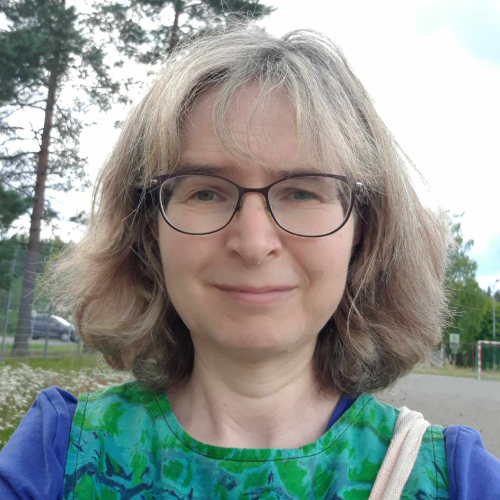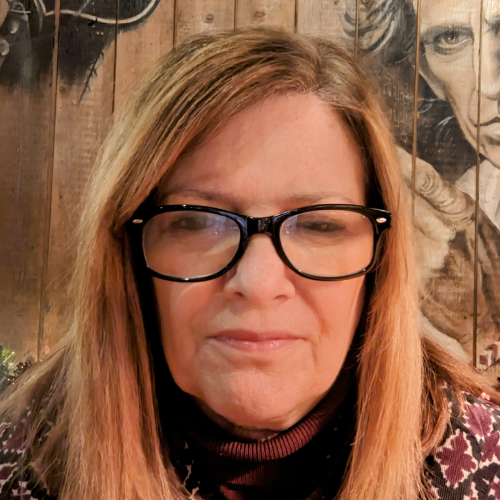


Ivonne Dekker
is a senior lecturer at the University of Applied Sciences in Utrecht, the Netherlands. She’s been here for 12 years now and teaches Media and Communication courses with a special interest in Media Psychology, news framing, and media and culture, which she loves.
She’s involved in graduate assignments, work placements and of course, virtual exchange. Formally, she lectured in South Africa
Judit Hahn
is a distinguished senior lecturer at the University of Jyväskylä in Finland, in the Department of Language and Communication studies. The university is located in central Finland. Judit teaches English majors and minors, offering courses in history, discourse studies and MA thesis studies.
She is especially interested in aspects of discourse and pedagogy in virtual exchange.
Both have had a long-term virtual exchange partnership over a number of years also with Katarzyna Radke, at the Adam Mickiewicz University in Poznań, Poland
Video-conferencing and virtual exchange
Judit realised she’d been doing virtual exchange for a number of years before she learned it was an actual pedagogical methodology at a conference she went to. She called it video conferencing at the time. But, what she was doing was in fact ‘virtual exchange’ and all that it entails.
Following a 3-way VE collaboration, together with Ivonne and Katarzyna, they undertook research in the field, focusing on student reflections. Reflections are an integral part of VE practice, say Ivonne and Judit.
“We gave them a drawing assignment’, explains Judit, ‘reflecting on a critical moment during their VE. They had to draw a magnifying glass and use that to reflect the moment. The drawings could be digital or hand drawings.
“Our analysis revealed certain themes. As teachers, it was very interesting to try and interpret them. We were able to do so because we had the background to the students and this perspective was crucial in enabling us to interpret the results.
Revealing analysis
“Meeting new people on Zoom for the first time was a critical moment for them. This is something that we mostly take for granted these days, but at the time, in 2019/20it was still new to many students. The other reflection that stood out was the issue of language proficiency and the differences the students experienced in that department.
Ivonne adds, “It was a really interesting project, with many critical moments that we had not anticipated. Katarzyna encouraged us to choose a different leader of the group each week. Being the leader meant that particular participant had to do everything: upload the tasks for the week for example and organise the synchronous meetings. To help, we used TRELLO for that which was very user-friendly.
“We noticed some students found this difficult as it took them outside of their comfort zone. However, once they had done it, they reflected that they had done something really good. As we all know, some students like to take a back seat, so this strategy proved a good way of getting them all involved in the collaboration.
The role of memes in a VE (and other fun stuff)
Ivonne continues; “In another of our projects, we asked the students to create a meme at the end of it. This proved to be very funny but also revealing in many ways. We had one student who was always late, for example. Of course, the other students noticed this and his tardiness was perfect fodder for a creative and humorous meme.”
Ivonne explains that some students created a wonderful click-through exhibition at the end of their VE collaboration, to demonstrate what they had created.
“Their 3D museum was such an extraordinarily immersive experience’, she says. ‘You clicked your way through the various projects that they had uploaded each week. In this way, all the students were able to see what the others were doing. We encouraged feedback, again using a TRELLO board.”
Challenges and Reflections
“Because the students had so many other obligations, it was challenging for them to find the time to fit in the VE tasks’, explains Judit. ‘And with a VE lasting around 6 weeks, which is pretty average, too many assignments can be an issue. That’s something I have learned,’ she adds.
Ivonne emphasises the importance of including a process of reflection in a VE collaboration.
“We asked the students to complete a portfolio at the end of each week, where they had to answer some questions that encouraged them to reflect on what worked and what didn’t and what would we change etc.”
Judit agrees that this proved very insightful for them and a good way to improve collaboration skills.
Lessons learned
“The biggest lesson for me’, says Judit, ‘and what I learned from the students, was mainly not to focus on the outcome and the content but rather create more space for discussions and for deep conversations.
“Outcomes mean they don’t have time to get to know each other and the students were reporting that their meetings were very ‘functional’. But that is not the point. The point is to create moments for deep conversations with people you’d never otherwise meet. We need to think about the present time, not do it for any future reason. I advocate removing the pressure of producing something and as a result, I made some changes to the structure of my next virtual exchanges.”
Ivonne concurs and says the focus should really be on the ‘process’ and not the final product.
Judit adds that virtual exchanges should be about ‘doing it for others’ and for ‘the present’, not ‘for yourself and for the future.’
“I really want to emphasis this aspect. These are projects that benefit all sides: to enable discussion, for meeting others, for deep conversations and for getting to know each other. It is so important for the NOW.
“We are diverse in so many ways, says Judit, ‘so students shouldn’t come with the expectation that students from the Netherlands are a different culture from them. This is not the point. It’s about seeing people as individuals. It’s also important to see in what ways we are similar.”
The importance of virtual relationships in VE
A few years ago, Judit undertook a VE with Iran. This is a perfect example when students had the chance to meet people from a place where they would never travel to.
But this was not an easy VE to get off the ground. It was risky in the extreme, especially for her Iranian VE partner, who was a woman and therefore at particular risk as a female scholar.
“This was at a time of tremendous upheaval in Iran (and it still is), and there were riots and revolts. I didn’t want to put my female counterpart in danger. So up till the very last minute, we didn’t know if we could do this or not. We could not use Zoom, so we used Skype.
But we did it and it was the most incredible and moving experience.
“Our Skype meetings were amazing. The Iranians were so pleased to share their voices, I can’t even put into words what this all meant to them.
“Despite intermittent internet access, they all kept trying to stay in the meetings. They wanted to be heard. ‘We want to know about Finland and we want to know about your education system and your lives’, they were asking. They told us they wanted to move to Finland, that they envied our freedom and education system.
“It was hard for my Finnish students to see such an outpouring of emotion. But they answered as best they could despite their initial shyness. They ended up making friends and the Iranians were so overwhelmingly happy to meet students from Finland.
“It was a truly wonderful and moving experience, as well as a clear cry for help”, concludes Judit. “That is what VE is all about.”
